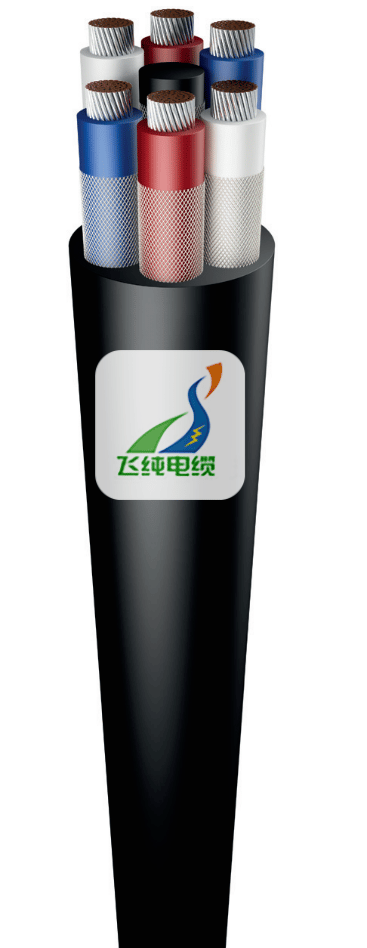Type OnGcekżi-G 0.6/1 kV Mining & Trailing Cable
Multi-core from 3 to 12 cores Mining cables with rubber insulation and sheath with individually screened cores for rated voltage 0.6/1 kV


Type OnGcekżi‑G 0.6/1 kV Mining & Trailing Cable:
General Description
Purpose:
A multi‑core cable designed specifically for underground mining applications. It is used for powering mining equipment and is suitable for hazardous environments (areas with methane or coal‐dust explosion risks).Voltage Rating:
Rated for 0.6/1 kV.Construction Standard:
Complies with Polish standard ZN‑95/MP‑13‑K1176.
Cable Construction
Conductors:
Made of multi‑stranded, tinned copper wires (class 5c per PN‑88/E‑90160).
The cable may have between 3 and 12 cores.
Typical Configuration:
For example, a 3‑core cable has 2 “working” conductors and 1 “protective” conductor.
Higher‑core cables include additional “auxiliary” conductors (e.g., a 7‑core cable might be arranged as 3 working + 1 protective + 3 auxiliary).
Insulation:
Each conductor is insulated with heat‑resistant rubber (IEP), meeting the PN‑89/E‑29100 standard.
Screening:
All working (and auxiliary) conductors are individually screened.
The screen is a braid made from tinned copper wires combined with plastic yarn, ensuring a minimum coverage of 65%.
Core Assembly (Ośrodek):
The screened working and auxiliary conductors are twisted together on top of a non‑insulated protective conductor.
(In some 3‑core and 10‑core versions, they are twisted together with two elements of the protective conductor.)
The cross‑section of the protective conductor includes the area taken by the screening layers.
Outer Jacket (Opona):
Made of flame‑retardant rubber (type ON‑4) per PN‑89/E‑29100.
The jacket is black in color.
Cable Designation Explained
The code OnGcekżi‑G breaks down as follows:
On: Indicates the outer jacket is made from flame‑retardant rubber.
Gc: Specifies that the insulation is made of heat‑resistant rubber.
ekżi: Means that each copper conductor is individually screened (using tinned copper wire).
‑G: Signifies that the cable is intended for mining applications.
Example:
A cable labeled “OnGcekżi‑G 3×2.5 + 2.5 + 3×2.5 mm²” means it is a 7‑core cable having:
3 working conductors (each 2.5 mm²),
1 protective conductor (2.5 mm²),
3 auxiliary conductors (each 2.5 mm²).
Operating Characteristics
Maximum Operating Temperature:
+90°CAmbient Temperature Range:
–25°C to +50°CTest Voltages:
Working Conductors: Tested at 3.2 kV
Auxiliary Conductors: Tested at 2 kV
Packaging:
Supplied on drums.Additional Option:
With customer agreement, the cable can be manufactured without screening on the auxiliary conductors.
Applications
Where Used:
Ideal for underground mining environments such as:Methane and non‑metallic mines,
Areas classified by explosion hazard (methane hazard grades “a”, “b”, or “c” and coal dust explosion classes “A” or “B”).
Electrical & Physical Parameters
Electrical Properties:
Detailed tables (provided in the full specification) list parameters such as:Conductor Resistance: (e.g., a 1.5 mm² conductor has about 13.7 Ω/km)
Current‑Carrying Capacity: (e.g., approximately 28 A for a 1.5 mm² conductor)
Unit Inductance, Reactance, and Capacitance: Values vary with conductor size.
Dimensional Data:
Tables also specify:Insulation Thickness,
Jacket Thickness,
Maximum Overall Cable Diameter
Approximate Weight per Kilometer for various conductor sizes and core configurations.

FAQ: Type OnGcekżi-G 0.6/1 kV Mining & Trailing Cable
Q1: What is the rated voltage of the Type OnGcekżi‑G cable?
A: The cable is designed for a rated voltage of 0.6/1 kV, making it suitable for low‐voltage applications in mining operations.
Q2: What core configurations are available?
A: This cable is available in multi‑core configurations ranging from 3 up to 12 cores, allowing for different setups based on the specific requirements of the mining installation.
Q3: What are the main components of the cable’s construction?
A: The cable features:
Working, Protective, and Auxiliary Conductors: Made of multi‑stranded, tinned copper wires.
Insulation: Heat‑resistant rubber (IEP) compliant with PN‑89/E‑29100.
Screening: Each working (and auxiliary) conductor is individually screened using a tinned copper braid with at least 65% coverage.
Outer Jacket: Made of flame‑retardant rubber (type ON‑4).
Q4: How does the cable address safety in hazardous mining environments?
A: The cable is specifically designed for underground mining and can be used in areas with methane or coal dust explosion risks. Its flame‑retardant outer sheath and robust construction help ensure safe operation in hazardous conditions.
Q5: What are the operating temperature limits of this cable?
A: The cable can operate at a maximum temperature of +90°C, with an ambient installation range from –25°C to +50°C, making it well suited for the variable temperatures found in mining environments.
Q6: What testing voltages are applied to the conductors?
A:
Working Conductors: Tested at 3.2 kV.
Auxiliary Conductors: Tested at 2 kV to ensure safety and performance.
Q7: Can the screening on the auxiliary conductors be modified?
A: Yes, upon customer agreement, the cable can be produced without screening on the auxiliary conductors if the specific installation requirements allow for it.
Q8: What standards does the cable comply with?
A: The Type OnGcekżi‑G cable complies with Polish standards such as ZN‑95/MP‑13‑K1176 for construction and uses components tested according to PN‑88/E‑90160, PN‑89/E‑29100, and others relevant to insulation and sheath materials.
Q9: How is the cable packaged and delivered?
A: The cable is typically supplied on drums, which is standard for mining cables to facilitate easy handling and installation in underground settings.
Q10: What makes this cable particularly suited for mining applications?
A: Its robust construction—including individually screened, tinned copper conductors, heat‑resistant insulation, and a flame‑retardant outer jacket—ensures durability and reliable performance in the demanding conditions of underground mining. It is specifically engineered to meet the stringent safety and performance standards required in hazardous environments.
Q11: What does the designation “OnGcekżi‑G” indicate?
A:
On: The outer sheath is made from flame‑retardant rubber.
Gc: The insulation is made of heat‑resistant rubber.
ekżi: The conductors are individually screened with tinned copper wires.
‑G: Indicates the cable is designed for mining applications.
Q12: What are some typical conductor configurations for this cable?
A: A common configuration is a 7‑core cable arranged as 3 working conductors, 1 protective conductor, and 3 auxiliary conductors. However, configurations can vary based on the number of cores needed, providing flexibility for different mining electrical system designs.






Type OnGcekżi-G 0.6/1 kV Mining & Trailing Cable
Type OnGcekżi‑G 0.6/1 kV Mining & Trailing Cable is a robust, multi‑core cable specially designed for underground mining applications. It features 3 to 12 cores, with each working, protective, and auxiliary conductor made of multi‑stranded, tinned copper. Each conductor is individually screened with a copper braid, ensuring high performance and electrical safety. The insulation is made from heat‑resistant rubber (meeting strict PN standards), and the outer sheath is constructed from flame‑retardant rubber, which is ideal for harsh, explosive environments like methane or coal dust zones. With an operating voltage of 0.6/1 kV, the cable is built to work in temperatures ranging from –25°C to +50°C and can handle a maximum temperature of +90°C. Its construction not only meets rigorous Polish standards but also ensures long‑lasting durability and safety in challenging mining conditions.
6/30/20215 min read
